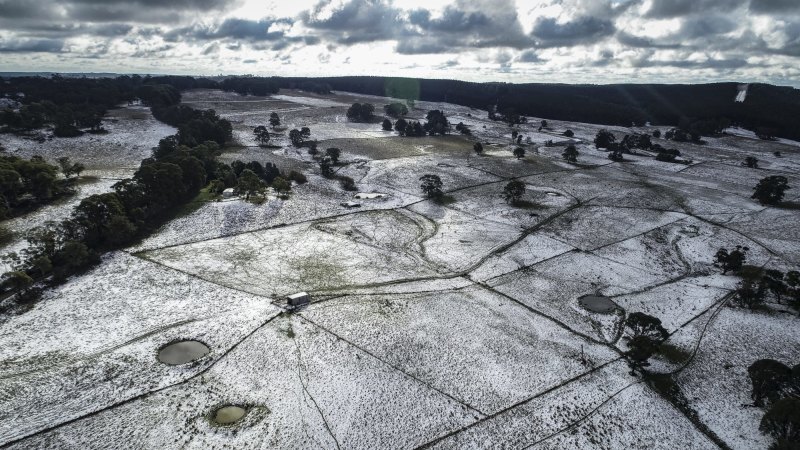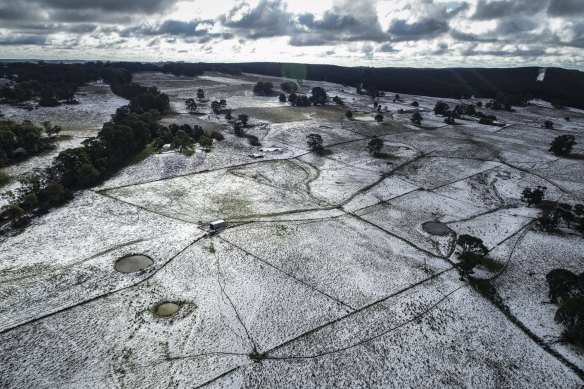Save articles for later
Add articles to your saved list and come back to them any time.
With weeks until the ski season starts, many holidaymakers are holding their breath to see how this season will stake up. Will the looming El Nino result in less snow? Or will they get lucky with a big dump? This season also offers a unique look into what the snow season of the future could be like, and how resorts will continue operating.
Temperatures and humidity in Australia’s alpine regions are increasing, while rainfall, snow seasons and snow depth are decreasing, as they have been doing since the 1950s. NSW government projections for the alpine region show minimum temperatures are projected to increase by half a degree or more by the end of the decade and 1.4 to 2.3 by the second half of the century.
Snow occasionally has northwards outbreaks, but in the long term, climate change will affect how snow resorts can operate.Credit: Wolter Peeters
Modelling by CSIRO predicts that under a low-risk scenario, the average snow season across Victoria and some of NSW will become 20 to 55 days shorter and, under a worst-case scenario, 30 to 80 days shorter.
Southern Alps Ski Club president Rod Peile said while the past few winters had had good snowfall, there would be years when they wouldn’t be so lucky. “We are concerned about what the future will be,” he said.
He said the group had signed long-term leases for several decades to continue operating at Charlotte Pass, Thredbo and Perisher, but less snowfall in the future could make business more challenging. He said that while snowmaking was effective now, increasing electricity prices might have an impact. “We’ve just got to keep on going,” he said.
What options do we have?
Australian Ski Areas Association chief executive officer Colin Hackworth said the future for snow resorts had never been brighter. “Australian ski resorts are more reliable than they have ever been,” he said. Hackworth credits snowmaking, snow grooming and a range of other technology in helping ensure there is enough snow. While he said climate change was a challenge, existing technology had helped reduce snow depth variability.
Snowmaking is just one method that snow resorts are drawing on to create the white stuff that coats the hills. The machines work by compressing water and forming a light mist. If it’s fine enough, this will linger in the cool air to crystallise and turn into snow.
But it’s a costly process that draws on a lot of electricity and water. Since 2007, Perisher has spent over $22 million on improving and expanding the resort’s snowmaking system.
“Investment in snowmaking technology continues to improve. It’s reducing its energy consumption, water consumption and can make snow at higher temperatures,” Hackworth said. “The number of operating days has never ever been higher than it is now. In the snow industry, before snowmaking, snow wasn’t a guarantee.”
Victorian Mt Buller ski resort spokeswoman Rhylla Morgan said the facility had invested in snowmaking infrastructure for decades because reliable snow underpinned most of the winter business on the mountain.
“Mt Buller led the way introducing Australia’s first snow-factory in 2017 with several resorts immediately following suit,” Morgan said
She added the facility, along with many others, relied on a range of technology “to provide predictable snow cover in an increasingly less predictable climate”.
“Australian alpine areas are keenly focused on the challenges of climate change and are adapting all aspects of operations to reduce emissions and carefully manage resources to ensure we can continue to welcome guests to enjoy winter alpine experiences for many years to come,” Morgan said.
But as climate change worsened, the window to make snow would become narrower, said Climate Council research director Dr Martin Rice.
In NSW, a report prepared by the government in 2019 found lower elevation locations might not be suitable for making snow in the future as there could be a more than 20 per cent reduction of suitable snowmaking conditions for 2020 to 2039 relative to 1990 to 2009. By 2060 to 2079, this could hit 60 per cent relative to 1990 to 2009.
“Essentially, climate change is making it increasingly hard for ski resorts to function at their best. Resorts can’t just rely on [natural] snow,” Rice, also a keen skier said.
He said water availability would also become an issue for ski resorts. Declining resources combined with higher temperatures would create complications about how water was shared among the agriculture industry and conservation and fire protection efforts.
Rice said the cost of making artificial snow would only become more expensive as climate change worsened. In many cases, resorts had begun to diversify and adapt their tourism to focus on year-round activities such as mountain biking and hiking trails in warmer weather.
“If we are going to protect our winter sports, we need to reduce greenhouse gas emissions. Failure to do so could end the run for the beloved ski season,” Rice said.
What are we likely to see this season?
While snow conditions are expected to vary from year to year and some seasons, Australia could see a fairly snowless season this year if current weather patterns in the Pacific and Indian oceans continue. As ocean temperatures warm in these regions, they will drive warmer and drier conditions over the mainland this winter. Below-medium rainfall is very likely for Australia between June and August.
It’s not good news for snow resorts. Weatherzone said the average snow depth at the official Snowy Hydro measuring station at Spencers Creek was about 198cm, but this average dropped by about 36 centimetres during an El Nino occurs, and there was a slightly greater loss when El Nino and a positive Indian Ocean Dipole occurred together.
The combination of both these weather patterns has happened just eight times since 1960, but it could occur again this year.
As we look forward, snow seasons in NSW and the ACT will be warmer. The number of cool nights in the area is expected to decline as well.
Less snow will also affect the suitable habitat for small mammal species in NSW and Victoria. Foxes have become more common at higher altitudes as the climate has warmed. And as snow cover declines, native animals are becoming easier for foxes to find.
In Victoria, snow cover has diminished by about 50 per cent since the 1960s.
Under a high-emission scenario, Victorian alpine areas are also projected to have a 35 to 75 per cent decline in snowfall by the 2050s, data from the state government shows. There are concerns that as snow depths decline, so will the number of visitors which would greatly affect the local economy.
Victoria’s northern resorts of that is Mt Buller, Mt Stirling, Mt Hotham and Falls Creek are projected to have adequate snow to support winter snow activities in the next 20 to 30 years with the help of snowmaking. The southern resorts, Mt Baw Baw and Lake Mountain, should have adequate snow to support winter snow activities in the next 10 to 20 years.
Perisher did not respond to a request for comment. Thredbo said they were two weeks out from snow season and were too busy to talk.
Most Viewed in Environment
From our partners
Source: Read Full Article




